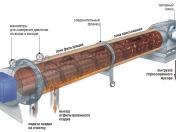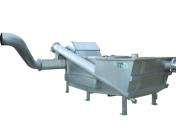Sludge Screens
Wastewater sludge usually contains a large number of dissimilar particles, including highly coarse materials of relatively large size, retained on screens: paper, wood, plastic, rubber, fibers, hair, textiles, and other debris.
If further treatment is expected, such materials must be previously removed, otherwise they can lead to clogging of pipelines and equipment breakdown.
Screens are used to remove the ingredients from the sediment leading to its heterogeneity.
Scope of the screens application
- Processing of sludge in the dewatering equipment (centrifuges, belt and chamber filter presses);
- Pumping of sludge by pumps;
- Digestion of sludge in septic, digestion and methane tanks;
- Thermal de-worming of sludge;
- Drying of sludge;
- Use in agriculture and production of construction materials.
Principle of the screens operation
The screen combines a screw press and a stainless steel sieve. The pressurized filtration of sludge through a cylindrical sieve, or by gravity through a special design belt, results in the separation of debris from the homogeneous organic part. Due to the different number of revolutions of the screw and the size of the sieve holes, it is possible to adjust the machine for processing different materials of various degree of dispersion. Simultaneously with the separation of debris, a partial dehydration of the sludge occurs. The plants can be equipped with stone collectors.
Sludge screens for treatment plants are one of the parts of the integrated wastewater sludge treatment systems developed by My Project, primarily for low-capacity systems - up to 60 m3/h of 95% humidity (per unit of equipment).



